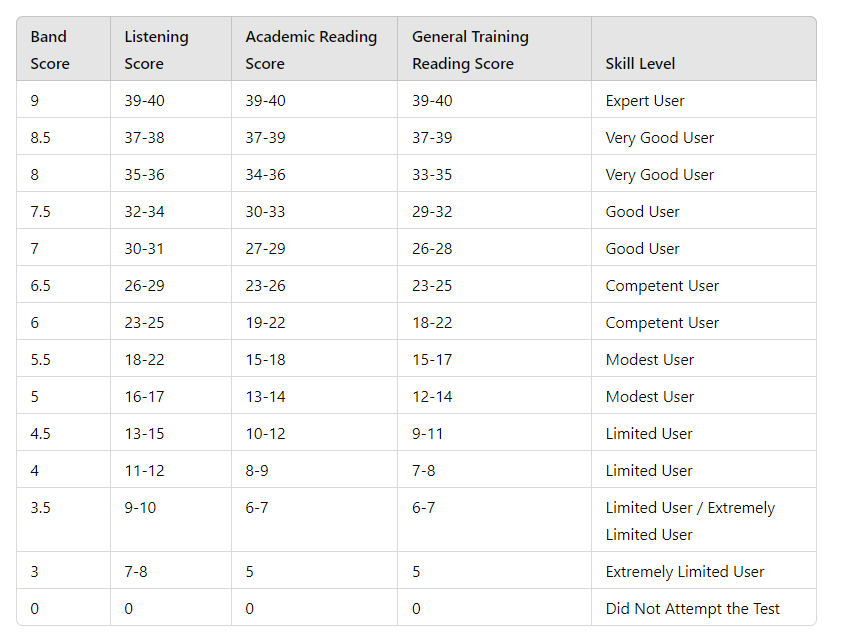
Unlocking the IELTS: A detailed review into the Marking Scheme - 10 min read ⏰
Preparing for the IELTS can feel like navigating a maze, especially when it comes to understanding how your test is scored. A clear grasp of the IELTS marking scheme can significantly boost your preparation strategy and, ultimately, your scores. In this blog post, we'll take an in-depth look at how each section of the IELTS is marked and provide you with practical tips to maximize your performance.
Listening and Reading Sections: The Basics of Scoring
Both the Listening and Reading sections of the IELTS are scored out of 40, as there are 40 questions. The Listening section has 4 parts each with 10 questions. You hear the audio only once with each one taking about 5 to 6 minutes. In total the audio is about 30 minutes long; you then have 10 minutes to enter you answers into the answer sheet. The Reading section has 3 parts which have 13, 13 and 14 questions respectively and lasts for an hour. Each correct answer nets you one point, which also need to be entered into an answer sheet. The total number of answers is then converted into a band score ranging from 1 to 9 (see the table towards the end of this blog post).

Listening Section:
There are 14 types of Questions: You'll encounter multiple choice, matching, plan/map/diagram labeling, form/note/table/flow-chart/summary completion, sentence completion, and short-answer questions.
Scoring: Each correct answer scores one point. After totaling your points, your raw score is converted into the IELTS nine-band scale.

Reading Section:
Academic Reading: This includes three long texts, varying from descriptive and factual to discursive and analytical.
General Training Reading: This also includes three sections but focuses on more practical content, ranging from factual information to complex workplace issues.
Scoring: As with listening, each correct answer is worth one point. Your total score is then converted to the band score.
Tips for Success:
Practice with different question types (there are 14 different types) to become familiar with the format.
Develop skimming and scanning techniques to quickly locate answers in texts.
Work on predicting answers based on contextual clues.

Writing Section: Breaking Down the Criteria
The Writing section comprises two tasks and is assessed using specific criteria. In total you are given 60 minutes to write both tasks, but as Task 2 carries twice as much weight as Task 1, it is recommended to spend 20 minutes on task 1 and 40 minutes on task 2
Task 1:
Academic: You'll need to summarize, describe, or explain visual data such as graphs, tables, or charts. It is
General Training: You'll be writing a letter, which could be formal, semi-formal, or informal.
Task 2:
This involves writing an essay in response to a given prompt, which can present a point of view, an argument, or a problem.
Assessment Criteria:
Task Achievement/Response:
For Task 1, this means how well you fulfill the task requirements.
For Task 2, it involves addressing all parts of the essay question(s) effectively.
Logical organization of ideas.
Use of cohesive devices (e.g., linking words).
Lexical Resource:
Range and accuracy of vocabulary.
Effective paraphrasing and use of less common words.
Grammatical Range and Accuracy:
Variety and accuracy of grammatical structures.
Sentence complexity and correct punctuation.
Tips for Success:
Study high-scoring model answers to understand what examiners are looking for.
Practice writing under timed conditions to manage your time effectively.
Focus on clear structuring of your essays and letters.

Speaking Section: Mastering the Interview
The Speaking section is a face-to-face interview, made up of 3 parts. Part 1 has three to four questions about the individual test-taker. This lasts about 4 minutes. The second part is a 2-minute monologue on a topic given by the examiner (it is written down for them). The candidate is given 1 minute, and paper and pencil, to prepare the speech. Part 3 is a flexible discussion between the examiner and the candidate (the candidate is expected to speak more than the examiner) based on the theme given for part 2. The speaking part is scored based on the following four key criteria:
Fluency and Coherence:
Ability to speak at length without noticeable effort.
Logical sequencing of ideas and appropriate use of cohesive devices.
Lexical Resource:
Range and accuracy of vocabulary.
Paraphrasing and use of less common expressions.
Grammatical Range and Accuracy:
Variety and accuracy of grammatical structures.
Complexity and error-free sentences.
Pronunciation:
Clarity and ease of understanding.
Use of intonation, stress, and rhythm.
Tips for Success:
Engage in regular speaking practice with a partner or coach.
Record and review your speech to identify areas for improvement.
Focus on clear and fluent speech rather than overemphasizing complex vocabulary.
Conclusion
Understanding the IELTS marking scheme is crucial to tailor your preparation effectively. By focusing on the specific criteria for each section, you can hone your skills and improve your performance, ensuring you achieve the highest possible band score. Keep practicing, stay consistent, and use the tips provided to navigate your IELTS journey successfully.
In the upcoming blog series, we will go even deeper into each skill tested by the IELTS. We will break down the marking criteria for Listening, Reading, Writing, and Speaking sections individually, offering you detailed insights and specific strategies to excel in each part of the test. Stay tuned for more comprehensive guides designed to help you conquer the IELTS!
By incorporating these detailed insights into your study routine, you’ll be well-equipped to tackle the IELTS with confidence and precision. Happy studying!


Article by Michael Lang
Published 16 Jun 2024